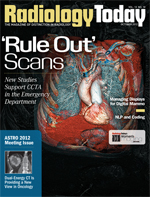 October 2012
October 2012
Tools and Carpenters
By Jim Knaub
Radiology Today
Vol. 13 No. 10 P. 3
Master carpenter Norm Abram’s skill with tools impressed me from the first episode of The New Yankee Workshop. I’d watch him build, say, a writing desk and be amazed at the dovetailed joints, matching lathe-turned legs, and evenly beveled desktop edge. Following a brief bout with the foolish thinking that I, too, could build that desk if only my garage workshop contained $30,000 worth of specialized power tools, it did not take long to figure out that it’s more about the carpenter than the tools.
My first visit to the operating room to watch eye surgery made a similar impression, only with exponential impact. Watching an ophthalmologist stick several sharp, pointy things into a man’s eye—and have it turn out to be a good thing—creates a clear impression about the steel and the skills of the person holding the pointy tools.
This whole idea of developing the skills to use the available tools came back into my consciousness when editing two articles that appear in this month’s issue. In both cases the tool is the CT scanner. Beth W. Orenstein writes on several recent studies using coronary CT angiography (CCTA) to triage patients who present to the emergency department with chest pain (see page 14). Being able to quickly determine that someone is not having a heart attack and can be sent home safely and then treated on an outpatient basis has obvious benefits and value. Researchers are looking at exactly how the CCTA tool can be used safely, effectively, and efficiently. If the ballyhooed shift from fee-for-service medicine to some other model that doesn’t incentivize providers on the volume of care provided comes to pass, using CCTA to provide the so-called rule-out exam could bring value to the system by reducing emergency department and admission time and charges, on top of improving patient care.
Similarly, Dan Harvey writes about how dual-energy CT offers a new view to oncology imaging. Low- and high-kilovolt energies produce different images in different materials. Some materials image better at lower energy levels and some at higher levels. As researchers learn more about how, for example, benign and malignant soft tissues may show up at different energy levels, they may be able to better characterize lesions on CT scans. This month’s article on page 18 looks at that work.
Sometimes you build a tool for a specific job. For example, think about the many, many kinds of wrenches in your toolbox at home; each serves a specific purpose. Dual-energy CT is more like a tool that radiologists and clinicians already have but are still working out exactly what they can do with it.
Enjoy the issue.
jknaub@gvpub.com

